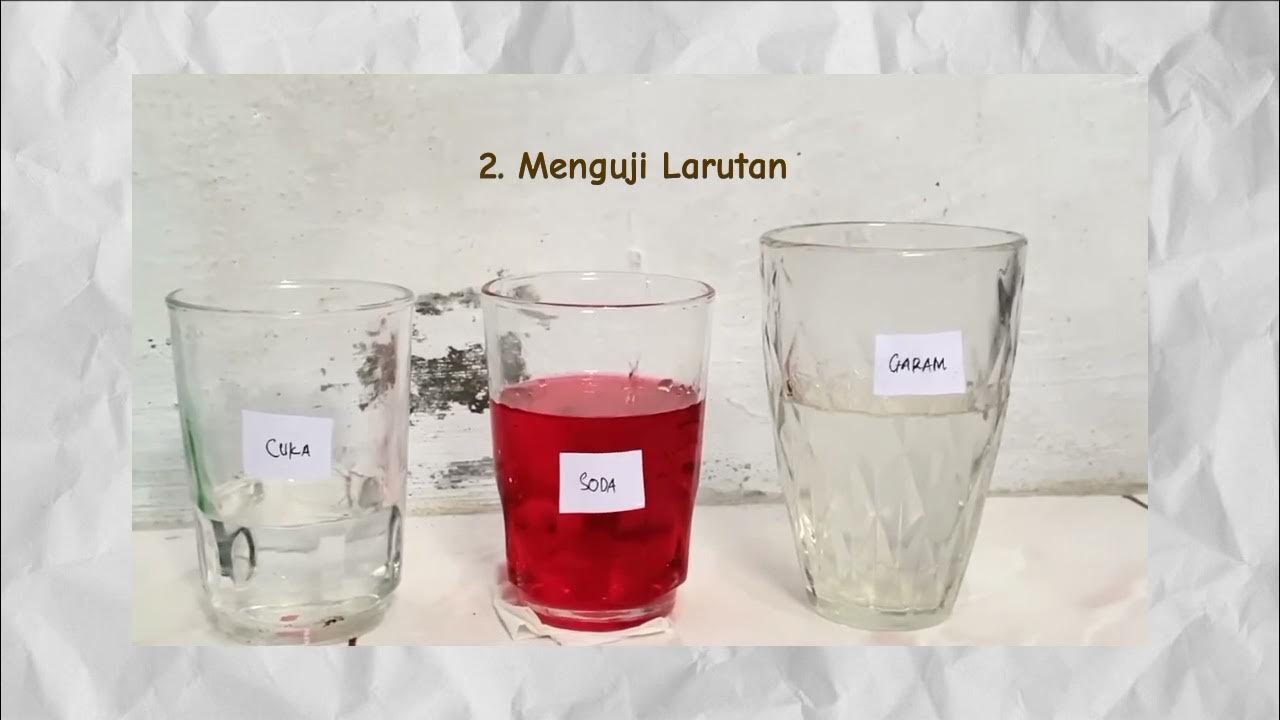Larutan Elektrolit dan Reaksi Redoks • Part 1: Larutan Elektrolit dan Nonelektrolit
Summary
TLDRIn this video, the channel provides a detailed explanation of electrolyte and non-electrolyte solutions, focusing on concepts from chemistry. The host introduces the fundamentals of compounds, distinguishing between ionic and covalent bonds. The discussion covers acids, bases, and salts, categorizing them into strong and weak, as well as their behavior in solutions. Additionally, the video delves into the conductivity of different types of solutions, explaining how electrolytes conduct electricity and the role of ion dissociation. Practical experiments, including the use of a light bulb to demonstrate conductivity, are also highlighted. The content aims to simplify these complex concepts for a better understanding of chemistry.
Takeaways
- 😀 Compounds are combinations of elements bonded chemically, either through ionic or covalent bonds.
- 😀 Ionic compounds are formed by positive (cation) and negative (anion) ions, while covalent compounds involve shared electrons between atoms.
- 😀 Acids are compounds that start with 'H', bases end with 'OH', and salts don't start with 'H' or end with 'OH'.
- 😀 Strong acids, bases, and salts completely dissociate in water, while weak acids and bases only partially dissociate.
- 😀 Strong electrolytes fully dissociate into ions in solution, allowing them to conduct electricity effectively.
- 😀 Weak electrolytes dissociate partially, leading to weaker conductivity in solution.
- 😀 Non-electrolytes are covalent compounds that do not dissociate into ions and cannot conduct electricity.
- 😀 A simple experiment involving a beaker, electrodes, and a light bulb can demonstrate whether a solution is an electrolyte or non-electrolyte.
- 😀 The conductivity of a solution depends on the number of ions present; more ions result in stronger conductivity.
- 😀 Gas bubbles around electrodes indicate the presence of electrolytes, with strong electrolytes producing more bubbles than weak electrolytes.
- 😀 Alfa (degree of dissociation) measures how completely a compound dissociates into ions, with strong electrolytes having Alfa = 1 and weak electrolytes having Alfa < 1.
Q & A
What is the main difference between electrolytic and non-electrolytic solutions?
-Electrolytic solutions are capable of conducting electricity because they contain ions that can move through the solution. Non-electrolytic solutions, on the other hand, cannot conduct electricity as they do not contain free ions.
What are the two main types of compounds based on their chemical bonding?
-The two main types of compounds based on their chemical bonding are ionic compounds and covalent compounds. Ionic compounds involve bonds between ions, while covalent compounds involve bonds formed by sharing electron pairs.
How can acids be identified in terms of their molecular formula?
-Acids can be identified by their molecular formulas, which typically begin with 'H' for hydrogen. Examples include HCl, H2SO4, HNO3, and H3PO4. However, CH3COOH is an exception as it does not start with 'H' but is still considered an acid.
What is the distinction between strong and weak acids?
-Strong acids, such as HCl and H2SO4, completely dissociate into ions in water, while weak acids, such as CH3COOH and H3PO4, only partially dissociate.
What are the defining characteristics of bases in terms of their chemical formulas?
-Bases typically end with 'OH', indicating the presence of hydroxide ions (OH-). Examples include NaOH, Ca(OH)2, and NH4OH.
What makes salts different from acids and bases?
-Salts are compounds formed from the neutralization of acids and bases. They do not begin with 'H' (like acids) or end with 'OH' (like bases). Examples include NaCl and CaCO3.
What factors determine the strength of an electrolyte solution?
-The strength of an electrolyte solution is determined by the extent of dissociation of the compound into ions. Strong electrolytes, like strong acids and bases, dissociate completely, while weak electrolytes only partially dissociate.
What is the role of ions in the conduction of electricity in electrolytic solutions?
-Ions are charged particles that move through the solution, allowing it to conduct electricity. The more ions present, the better the solution conducts electricity.
How can the strength of an electrolyte solution be experimentally determined?
-The strength of an electrolyte solution can be determined by observing the brightness of a connected lamp in a circuit. A stronger electrolyte will result in a brighter light, indicating better conductivity, while a weaker electrolyte will produce a dimmer light.
How do the properties of ionic and covalent compounds differ in terms of their electrical conductivity?
-Ionic compounds can conduct electricity when dissolved in water or melted, as they dissociate into ions. Covalent compounds generally do not conduct electricity, unless they are polar covalent compounds in solution.
Outlines

此内容仅限付费用户访问。 请升级后访问。
立即升级Mindmap

此内容仅限付费用户访问。 请升级后访问。
立即升级Keywords

此内容仅限付费用户访问。 请升级后访问。
立即升级Highlights

此内容仅限付费用户访问。 请升级后访问。
立即升级Transcripts

此内容仅限付费用户访问。 请升级后访问。
立即升级浏览更多相关视频

SKL (2)| Kenaikan Titik Didih (∆Tb) | Penurunan Titik Beku (∆Tf)

3 1 1 Penurunan Tekanan Uap, XII MIPA

Tekanan Uap Larutan Non Elektrolit | Kimia SMA | Tetty Afianti

SKL (1) | Penurunan Tekanan Uap (∆P) | Kimia Kelas 12

video praktikum sederhana " Larutan Elektrolit dan Non elektrolit"

PENENTUAN REAKSI REDUKSI DAN OKSIDASI PADA SEL ELEKTROLISIS
5.0 / 5 (0 votes)
